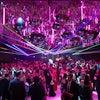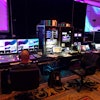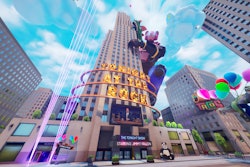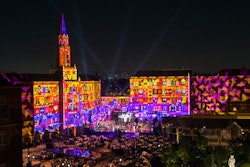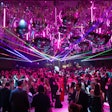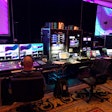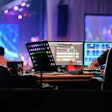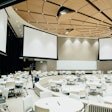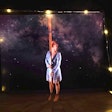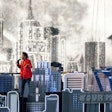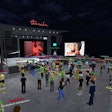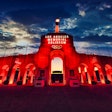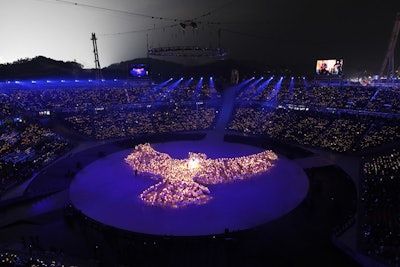
The opening ceremony of the 23rd Winter Olympics in Pyeongchang, South Korea, took place February 9, delivering a technology-heavy spectacle mixed with momentous political moments to the 35,000-seat Olympic Stadium and 27.8 million viewers on NBC. The “Peace in Motion”-theme ceremony, which was helmed by executive creative director Song Seung-whan, took viewers on a journey through South Korea’s past, present, and future through the eyes of five children—representing the five elements of fire, water, wood, metal, and earth—in a winter fantasy atmosphere.
Along with a number of song and dance performances that viewers come to expect from an Olympic opening ceremony, highlights included colorful projection-mapping technology on the stadium floor, augmented-reality segments for viewers at home, 1,270 people creating the image of a dove with LED candles during a performance of John Lennon’s "Imagine," and Intel’s Guinness World Record-breaking light show that incorporated more than 1,200 drones.
Outside of the production itself, the event saw a unified North and South Korea walk together to culminate the parade of athletes as well as the presence of Kim Yo Jong, Kim Jong Un’s sister, in the audience. Here’s what event producers liked and disliked about the kickoff to the Pyeongchang Olympics.
Mark Stewart
"Like most of the world, I have always watched Olympic opening ceremonies from the comfort of home, until this year. I am lucky enough not only to be in Pyeongchang to assist with some projects we are doing for our Olympic sponsor clients, but I also scored a ticket to this once-in-a-lifetime event thanks to the great folks at Canadian Tire.
From the moment we walked into Olympic Stadium, there was an overwhelming sense of excitement and pride from everyone we met. As we looked around, the first thing that blew my mind was the individual LED panels above and behind each seat. The sheer scale of the number of panels, miles of wiring, and display technology had me waiting like a kid before Christmas for the show to begin. Add in a flat stage and obvious raising platforms waiting to emerge as well as the projectors hundreds of feet above the center of the stadium, and I knew we were in for something special.
When the show did start, it did not disappoint. The theme of peace was woven into the show seamlessly and was not forced. Not since London 2012 have I seen a ceremony with so much heart. While we did not have the commentary of the show from a traditional TV broadcast, everything was clear as to what it all meant. And frankly, sometimes being able to create your own narrative gives a show a deeper meaning for you. As the show went on, this was definitely a technology-driven story with massive heart, complemented by some of the best art direction [I’ve seen] in recent years. The colors, LED panel animations, the use of space, and the music came together in a unified way.
As the athletes emerged, the dancers on the ground in a circle had a massive team to help them in the stands for spectators, each getting the crowd going—and staying warm—and they never stopped or toned down their enthusiasm. These are the things you would miss on a TV broadcast—and like a lot of the projects we do, the live experience, along with smart technology integration, really made this work for me. Then, the drones started their show. There is nothing I can say that many others have not already said about Intel’s show. It was a groundbreaking moment in this technology, and the ability to animate using drones as pixels in a way I’ve never seen before literally had me standing and cheering in the stadium. As the flame was lit, my hands were cold, my face chilled—but my heart was warm and full of positivity for how wonderful this world we live in could be. It’s a show I will never forget, much like the people of Korea, and the rest of the globe."
Letter grade: A
Stewart is the president and chief operating officer of Wondermakr, a Toronto-based creative technology agency that produces live experiences. Clients have included Disney, Hilton Hotels & Resorts, JetBlue, and Toyota.
Kelsey Harlow-Nash
"The mixing of live athletes and drones to create the moment down the ski slope was something I really enjoyed. The unity of everyone coming down the mountain, mixed with the drones creating snowboard imagery into the rings, was something truly great to see at this year's Olympics, and a great integration of modern technology. I also loved the sense of how a unit is better than one, seen throughout the whole opening ceremony from the drums to the use of dancers.
I would love to see them mix up how the athletes are brought into the stadium. I know this is a staple of the opening ceremony but it does seem to go on for a long time.
I liked the integration of augmented reality into the ceremony. It felt like a good use of modern technology, as well as the integration of the light show in the center disc. In such a large space it was nice to see the scene change and not be focused solely on projection mapping."
Letter grade: B
Harlow-Nash is the director of production for Agenc, a Los Angeles- and New York-based experiential and digital marketing agency. Clients have included Target, L’Oréal, Vanity Fair, and Hulu.
Kristian Manchester
"In a nutshell, the show was designed as a wintery fairytale with a message of peace. My feeling is that the opening ceremony set out with the best intentions. With children as the heroes and peace as the storyline, they created the right mindset for the countries in attendance. North and South Korea both walked the proverbial walk and set the example in terms of what the Olympics are all about: For the next 18 days, let’s put aside our difference and mean Twitter accounts and celebrate human potential.
Overall, the show didn’t really exceed my expectations. There were a few good moments but the red thread connecting the scenes was missing, perhaps because the storyline relied too heavily on the five characters. Still, the quality of the CG in the film and the sophistication of the projection mappings lived up to the reputation of the technology-driven country that gave Samsung to the world. I actually wish more artistic mapping would have been integrated into the story to help make the puppet show more immersive.
Still, the opening ceremonies ended on a high note, with John Lennon’s 'Imagine' and the lighting of the cauldron by two athletes from each faction—a resounding gesture by a divided Korea."
Letter grade: B
Manchester is the global executive creative director and partner of Sid Lee, a creative agency with offices in Montreal, Toronto, New York, Los Angeles, and Paris. Clients have included the Canadian Olympic Committee, the North Face, Facebook, and the N.B.A.
Ryan V. Thompson
"The ceremony remained focused on its own modest yet progressive place in the world, featuring performances by South Korean musicians and appearances by South Korean athletes as well as softly promoting Korean unification and world peace while avoiding any more poignant position on global issues or politics.
The proliferation of screens and shareability was clearly on the conscious of Seung-whan, with nearly every aspect of the event primed for multimedia viewing. From the social currency captured on mobile phones of nearly 3,000 Olympic athletes to the near-immediate meme-generating, and polarizing, nature of Inmyeonjo—the 'human-faced bird' in a world of screens—nothing was simply as it seemed. This is a feat unto itself, however, when taking into consideration the complexities of onsite field and stage production, live streaming online, and primetime televised broadcast in different time zones around the world, the magnitude of achievement really unfolds.
One element of particular note was the use of augmented reality, a technique primarily designed for the television audience. At one point, for example, a passage of the performance depicted the constellations above the Korean sky, which for viewers at home formed a stunning dome above the circular ground-level stage. However, those in the stadium were looking at performers pretending to look up at something that, in reality, wasn’t there. Ideally these fans, traveling great distance and braving below-freezing temperatures, would be given the opportunity to experience the same augmented-reality-fueled entertainment on their mobile phones as TV-viewing audience watching at home.
Another reality check worth highlighting, not particularly ground-breaking but couldn’t be missed, was the swarm of drones swirling down the slopes of the Taebaek Mountains with pyrotechnic and LED-illuminated skiers and snowboarders below, creating a fantastical combination of art and technology in-motion. The world record-setting display certainly one-upped Lady Gaga at last year’s Super Bowl, but the value-add to Seung-whan and his creative vision came at the cost of inauthenticity and irrelevance. What is the right balance between the live experience of tens of thousands in attendance, compared to the hundreds of millions being reached through digital and televised mediums? Sure, it scored high on cool factor, but the sky visual of a snowboarder felt disconnected from the ceremony’s creative narrative, the disclosure that the drone display was actually pre-taped felt mandatory, and advertisement first-to-air at next commercial break of broadcast felt gratuitous. Even the planned, in-stadium, 300 drone display was scrapped at the last minute, due to 'impromptu technical challenges.' Again, for the sake of the 35,000 fans, athletes, and delegates present, a more ‘real’ visual in the stadium would have been apropos.
Overall, for all the creative complexities, budget limitations, stakeholder expectations, and performance elements to be managed when producing a world-class event of this magnitude, this was a huge accomplishment."
Letter grade: A-
Thompson is the vice president of creative services for Ideko Productions, a New York-based experiential production agency. Clients and events have included Red Bull, Nike, Clif Bar, and NYC Summer Streets.
Will Milligan
"The heavy political drama of the Winter Olympics in South Korea was eclipsed by the imaginative cultural and technological journey of the opening ceremonies. The source of the Olympic athletic spirit—strength, poise, and determination—was gracefully on display with a creative and dazzling story of children, animals, and audiovisual wonder. In event planning, we want our efforts and results to be memorable. I think the opening ceremony achieved that."
Letter grade: A
Milligan is the president and founder of Will Milligan Events, a Washington-based event planning firm. Clients have included Amazon, Moët Hennessy, Technet, and the National Association of the Deaf.
Heather Salkin
“Overall, I think the opening ceremony hit the mark on what was expected on this global stage. Interestingly, my highlight is also one of my critiques. I was thrilled that they finally integrated augmented reality into a broadcast for the masses. I found the AR layer of the Korean star map rising above particularly stunning and appropriate. However, it’s my opinion that they could and should have gone much bigger for this Olympic audience—and with this Olympic budget. Taking notes from eSports championship broadcasts and knowing the future of gaming and remote spectatorship has already advanced eons past the subtle graphical treatments here, I was disappointed and saw a significant missed opportunity where they could have authentically propelled Korea forward in the conversation about the future of technology.
The use of AR with the children doodling in a moonlit boat toward the night sky led to my favorite storyline of the program. These children, who were the common thread throughout much of the opening ceremony’s storyline, passed through what I’ll call ‘transitional portals’ into a view of their tech-driven future selves. While I found this theme ironic, as Korea has the second highest number of tech rehab facilities in the world, the sentiment and creative expression of this vision was inspiring, modern, and elegant.
I had been waiting since December to see how the Intel drones would show up during the ‘live’ program after hitting the Guinness World Records that month in prep for the games. I later learned that due to last-minute ‘impromptu logistical changes,’ they never got off the ground. Previously shot footage was used. While the footage was breathtaking—mind-blowing to be fair—it was a disappointment to learn that as an industry, we aren’t quite yet there with the reliability of these Shooting Star drones lighting up the sky above our events.”
Letter grade: B+
Salkin is the senior vice president of innovation at Momentum Worldwide, a global brand experience agency with headquarters in New York. Clients have included American Express, Verizon, Coca-Cola, and Mondelez.
Tom Kehoe
"Overall, I felt the opening ceremony was nice, yet not as exciting as I was hoping for. I liked the man-made animal icons, and felt that those were a nice balance to the technical aspects. The LED and video components were awesome. The parade of athletes needed a higher level of excitement. The lighting of the torch was lackluster. The simulation of the drones was well-done, and I would have liked to have seen more of that. The musical performers were underwhelming."
Letter grade: C
Kehoe is the president of Kehoe Designs, a Chicago-based event design company. Clients have included the N.F.L., C3 Presents, and the Sheraton Grand Chicago.
Reviews have been edited and condensed.
